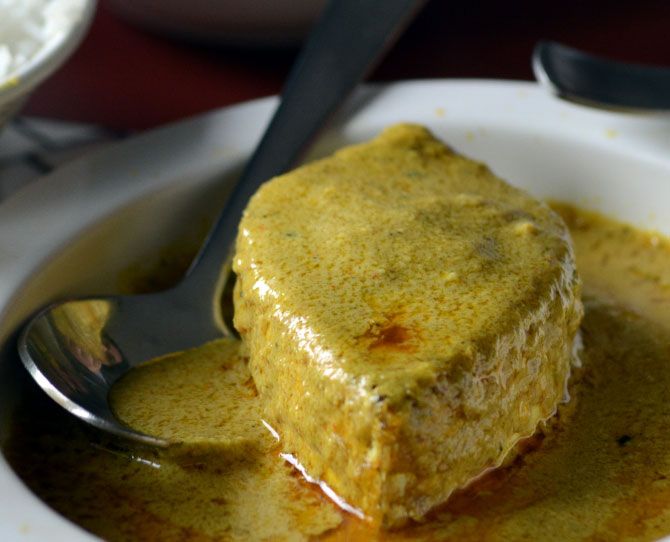 | « Back to article | Print this article |
Here's your opportunity to sample ilish dishes from the royal homes of Bengal, says Avishek Rakshit.

For people in the Bengal-Bangladesh belt, the subtle-flavoured, fine-boned ilish is akin to fish royalty.
They often spend a small fortune on it -- in Kolkata recently a 3 kg specimen sold for over Rs 15,000.
The most prized variety is available only in the monsoon.
The illustrious hilsa -- its anglicised name -- originates in the coastal waters of Myanmar and travels all the way to the mouth of the Ganga in West Bengal and rivers like the Padma and Meghna in Bangladesh to lay eggs in fresh water during the monsoon.
Once ready to brave the harsh saltwater of the Bay of Bengal, the little fish return to their original habitat with their parents
Despite some 500 years of appearing on the Bengali table, the hilsa hasn’t changed its course and obligingly still lands in the fisherman’s net.
Bengal’s royal households have a natural affinity with this king of fish -- several rajbaris (literally, royal houses) developed their own hilsa delicacies over the centuries.
And this month, the commoner can eat like a king too, with the ITC Sonar hotel in Kolkata offering specialities from four rajbaris on its ‘Hilsa Royal Menu’ at the Eden Pavilion restaurant.
Atul Bhalla, area manager-East at ITC Hotels, says, “Four distinguished families are participating. Some of these recipes date back to the 1600s.”
To partake of this hilsa menu is to be immersed in fascinating history.
Perhaps the very first hilsa innovation, Ilish Macher Dum Polao, can be attributed to the 17th century ancestors of Siddhartha Bahubalindra of the Moynagarh Rajbari.
During his visit to Jahangir’s court, Raja Paramananda Bahubalindra is said to have been taken with the Mughal dishes that combined Persian, Turkish and West Asian dishes with Indian flavours.
“After he returned, he began testing those dishes with fish,” says Bahubalindra.
Another innovation from this rajbari is Ilish Macher Mol, where the fish is cooked in boiled water and coconut milk gravy. This was introduced by Jagadanada Bahubalindra in the 18th century, marrying ingredients from South Bengal with cooking methods from the court of Siraj-ud-Daullah in North Bengal.
The Sovabazar Rajbari is credited with introducing hilsa to the British in the 18th century.
The house’s boneless Smoked Ilish was cooked by chefs who specialised in catering to the Western palate and was served to colonial eminences including Lord Wellesley, Lord Clive and Warren Hastings.
Salma Deb of the Rajbari says, “Smoked Ilish is the only dish the British could eat with knife and fork.”
The Sugandhi Ilish Bhapa -- a favourite of Raja Nabakrishna Deb, founder of this rajbari -- in which the fish is cooked in silky yogurt and mustard gravy and finished with Bengali masala, was reserved for Bengal Renaissance stalwarts like Ishwar Chandra Vidyasagar and Raja Ram Mohan Roy.
Pallab Roy, scion of the Cossimbazar Rajbari, says their Madhu Malai Ilish dates to 1898.
The story goes that his ancestor, Raja Ashutoshnath Roy, spent all his time hunting, playing polo and horse-riding. His wife, Sarojini Devi, devised the dish as a way of luring her husband home.
The fish is cooked in coconut and yogurt gravy, sweetened with honey and finished with a dash of lemon juice.
The Zafrani Ilish from the Posta Rajbari, perhaps the most expensive of all hilsa dishes, dates to 1917, when Rani Kasturi Manjuri Dasi invented a mild dish for her son Kumar Bishnuprasad Roy’s return from the Grand Tour.
Riddhiman Roy of Posta Rajbari says, “There had to be a feast to celebrate the homecoming. The who’s who of Kolkata was invited and she needed to display her culinary talents.”
Thus was born the Zafrani Ilish: soft on the palate, cooked in cashew-nut gravy, finished with saffron milk and garnished with raisins.
The royal menu is priced at Rs 2,000 plus taxes, and includes one royal hilsa dish, rice, fried hilsa, hilsa egg and oil, hilsa head cooked with leafy vegetables and a potato dish. Available till August 31 at the ITC Sonar, Kolkata.